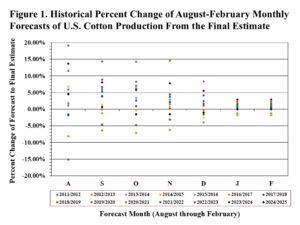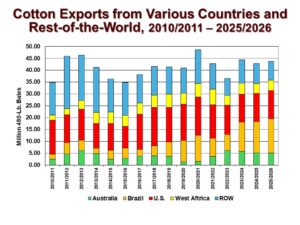Policy Uncertainty. Policy changes are a common source of surprises (“shocks”) to cotton market outcomes. Recent years provide numerous case studies. Some examples include India’s domestic minimum support price program; the U.S. 2018 farm bill updated with the commodity title elements in the 2025 Budget Reconciliation bill (“One Big Beautiful Bill”); the U.S.-China Phase One Agreement; the U.S. Market Facilitation Program; the U.S. CARES Act; U.S. trade sanctions on products from Xinjiang Province; and the periodic policy announcements of the Chinese National Development and Reform Commission, which include management of their cotton reserves, and cotton import quota announcements. The unexpected string of tariffs and counter-tariffs are the most recent example of policy shocks. The retaliatory tariffs by China on U.S. cotton should have minor impact because of the relatively small volume of U.S. cotton sold to China this year. However, the impact of the unexpected tariff announcements is increasing general uncertainty which can have a wet blanket effect on the cotton futures market.
Supply Uncertainty
The cotton market continues to focus on the question of the size of the 2025 U.S. cotton crop. The first question is how much acreage was planted. Until we get more certified acreage data from USDA FSA, the working forecast of planted acreage is 9.3 million planted acres measured in USDA’s November 14 WASDE report.
The forecast of production must then take into consideration crop progress. The pace of U.S. cotton harvest remained on par at 71%, as of November 16, 2025. The last published condition rating for the 2025 Texas crop remained in the upper third of historical ratings for this time of year (see chart below). The U.S. cotton condition ratings remained at 47% “Good/Excellent with 36% rated “Fair” as of September 28.

This column from September 3 summarizes the good cotton growing season in Texas. The weekly regional summaries (click here and scroll down) for Texas reflected a mix of conditions. An overall drying conditions is reflected in the drought monitor map.
In the aggregate, USDA’s production forecast of 13.22 million bales of U.S. all cotton will be refined with improved information flow. That information flow includes additional grower survey data, forecasted ginnings, and a count of bales classed. The most recent ginning forecast (as of September 15) reflects 338,200 running bales (or 347,517 statistical bales) ginned, which is 2.6% of NASS’s current production forecast of 13.22 million bales of U.S. all cotton. The early 2025 crop classing reports (latest for week ending October 23) reflects 2,337,874 running bales (or 2,402,282 statistical bales), which is 18% of NASS’s current production forecast of 13.22 million bales of U.S. all cotton. The production forecast refinement is historically reflected by the narrowing of the percent monthly deviations of the first (August) to later (February) monthly forecast (see Figure 1 below).

Global new crop cotton supply and demand of cotton has similar influences as those in the U.S. For example, foreign cotton production, among other variables, could be higher than currently projected. This could happen if India and Pakistan’s above average monsoon rains are a net benefit (i.e., greater plantings and higher yields outweigh flood damage) especially in India’s cotton-dense states. Note: the reverse may be true in the Punjab regions of Pakistan and northern India where flood damage may trump crop productivity gains. Looking ahead, the current forecast for September rains in India is 109% of the 50 year average. Strong foreign production could also result if Brazilian and Australian maintain trend-line production in the near term. Brazil has reportedly been underselling U.S. cotton by five cents a pound by virtue of their greater productivity. This has led to a dramatic expansion of Brazilian exports, as shown below.

Demand Uncertainty. For U.S. cotton, the two main demand categories are domestic mill use and exports. Domestic U.S. consumption is forecasted by USDA at only 1.7 million bales. Exports are generally a more important source of demand as they represent over 80% of U.S. cotton use.
As shown below, the destination of U.S. exports has been changing. In the last three years, China’s policy-driven cotton imports has shifted from boom to bust. That leaves the U.S. competing for cotton exports to Southeast and South Asian destinations, as well as other regions of the world.

The main indicators of U.S. export demand are weekly sales and shipments of U.S. cotton. Recent 2025/26 export sales numbers have been from weak to modest. For example, for the week ending September 18, weekly net sales of U.S. cotton were 94,600 bales of all cotton. Other export indicators like weekly shipments and total commitments reflect relatively weak export demand.
Lastly, there is the question of longer term demand. I am cautious about the possibility of macro headwinds related to world GDP, inflation, and central bank policy. Stagflation is a possible risk that is historically associated with declining cotton demand. Short of that, just having low, slow growth in the world economy could deprive the cotton market of sustained price support, leaving only the volatile and short lived weather market influence discussed above.